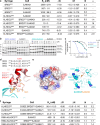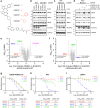Principles of paralog-specific targeted protein degradation engaging the C-degron E3 KLHDC2
- PMID: 39396041
- PMCID: PMC11470957
- DOI: 10.1038/s41467-024-52966-3
Principles of paralog-specific targeted protein degradation engaging the C-degron E3 KLHDC2
Abstract
PROTAC® (proteolysis-targeting chimera) molecules induce proximity between an E3 ligase and protein-of-interest (POI) to target the POI for ubiquitin-mediated degradation. Cooperative E3-PROTAC-POI complexes have potential to achieve neo-substrate selectivity beyond that established by POI binding to the ligand alone. Here, we extend the collection of ubiquitin ligases employable for cooperative ternary complex formation to include the C-degron E3 KLHDC2. Ligands were identified that engage the C-degron binding site in KLHDC2, subjected to structure-based improvement, and linked to JQ1 for BET-family neo-substrate recruitment. Consideration of the exit vector emanating from the ligand engaged in KLHDC2's U-shaped degron-binding pocket enabled generation of SJ46421, which drives formation of a remarkably cooperative, paralog-selective ternary complex with BRD3BD2. Meanwhile, screening pro-drug variants enabled surmounting cell permeability limitations imposed by acidic moieties resembling the KLHDC2-binding C-degron. Selectivity for BRD3 compared to other BET-family members is further manifested in ubiquitylation in vitro, and prodrug version SJ46420-mediated degradation in cells. Selectivity is also achieved for the ubiquitin ligase, overcoming E3 auto-inhibition to engage KLHDC2, but not the related KLHDC1, KLHDC3, or KLHDC10 E3s. In sum, our study establishes neo-substrate-specific targeted protein degradation via KLHDC2, and provides a framework for developing selective PROTAC protein degraders employing C-degron E3 ligases.
© 2024. The Author(s).
Conflict of interest statement
D.C.S., S.D., E.G., S.C.C., J.R., R.T., C.T.G., H.W.L., J.O., T.C., R.E.L., and B.A.S. are listed as co-inventors in patent filings associated with the technologies described in this manuscript. D.C.S. and B.A.S. are co-inventors of intellectual property that is unrelated to this work (DCN1 inhibitors licensed to Cinsano). J.W.H. is a founder and consultant for Caraway Therapeutics and is a scientific advisory board member for Lyterian Therapeutics. S.J.E. is a founder of, and holds equity in, TScan Therapeutics and Immune ID. S.J.E. is also founder of MAZE Therapeutics, and Mirimus and serves on the scientific advisory board of TSCAN Therapeutics, and MAZE Therapeutics. In accordance with Partners HealthCare’s conflict of interest policies, the Partners Office for Interactions with Industry has reviewed SJE’s financial interest in TSCAN and determined that it creates no significant risk to the welfare of participants in this study or to the integrity of this research. B.A.S. is a member of the scientific advisory boards of Biotheryx and Proxygen. The remaining authors declare no competing interests.
Figures






References
-
- Verma, R., Mohl, D. & Deshaies, R. J. Harnessing the Power of Proteolysis for Targeted Protein Inactivation. Mol. Cell77, 446–460 (2020). - PubMed
-
- Ramachandran, S. & Ciulli, A. Building ubiquitination machineries: E3 ligase multi-subunit assembly and substrate targeting by PROTACs and molecular glues. Curr. Opin. Struct. Biol.67, 110–119 (2021). - PubMed
Publication types
MeSH terms
Substances
Grants and funding
- P30 GM133893/GM/NIGMS NIH HHS/United States
- NIH P30CA021765/U.S. Department of Health & Human Services | NIH | National Cancer Institute (NCI)
- 5RO1CA247365/U.S. Department of Health & Human Services | NIH | NCI | Division of Cancer Epidemiology and Genetics, National Cancer Institute (National Cancer Institute Division of Cancer Epidemiology and Genetics)
- R01GM132129/U.S. Department of Health & Human Services | National Institutes of Health (NIH)
- R01 CA247365/CA/NCI NIH HHS/United States
- Investigator/Howard Hughes Medical Institute (HHMI)
- R01 AG011085/AG/NIA NIH HHS/United States
- P30 CA021765/CA/NCI NIH HHS/United States
- NIH R01AG11085/U.S. Department of Health & Human Services | NIH | National Institute on Aging (U.S. National Institute on Aging)
- R01 GM132129/GM/NIGMS NIH HHS/United States
- Schulman department/Max-Planck-Gesellschaft (Max Planck Society)
LinkOut - more resources
Full Text Sources
Molecular Biology Databases

